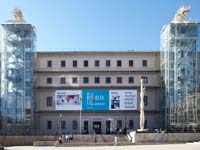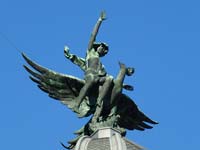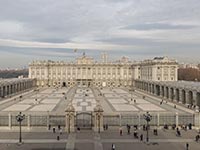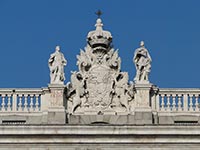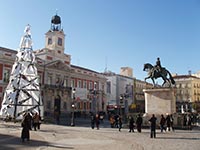Things to do in Madrid, SPAIN
As the heart of one of the most historically important empires in the world, Madrid is the perfect juxtaposition of tradition and modernity.
The Spanish capital has been an European centre of politics and culture for centuries. It has played a key role in many of the major events of the continent and the country, and its importance is evident in the air with which it carries itself. Dignified, grandiose, and beautiful, the architecture seems at once inviting and out of reach.
Madrid, however, isn’t all about royalty, elegance, and monuments. Its inhabitants bring colour and flavour to everyday life with constant music, delicious food, and one of the world’s greatest nightlife scene. After all, they are famous for staying up all night, and ending the party with breakfast.
Vast parks, such as El Retiro, bring splashes of green into the bustle of modernity. Public spaces, such as the Plaza Mayor, offer stunning architecture. Museums, such as Museo Nacional Reina Sofia, offer plenty for culture vultures or a rainy day. Alternative bars bring some grime into the manicured avenues, and a joy of life overtakes inhabitants and visitors alike.
If you’re looking to make the most of your time in this beautiful city, here are the top things to do.
1. Museo Nacional del Prado
With 7,600 paintings, 1,00 sculptures, and an impressive collection of European art, it is Spain’s main art museum.
The Museo Nacional del Prado is one of the most visited in the entire planet, and it’s not difficult to see why. With thousands of paintings, sculptures, manuscripts, and drawings, its collection is matched by few other museums.
Housing masterpieces by Goya, Velazquez, El Greco, Caravaggio, Rubens, and many other artists, a visit to Madrid demands a visit to El Prado. To miss it would be to miss the very essence of the city, which prides itself in its commitment to art and culture.
Velazquez’ Las Meninas is by far the collection’s most famed piece, followed closely by others like Goya’s Saturn Devouring his Son, and Rubens’ The Three Graces.
where? The museum is located on the Paseo del Prado in the city centre. To get there, go to the Madrid Atocha metro station.
when? El Prado is open Monday through Saturday from 10:00 a.m. to 8:00 p.m., and Sundays and holidays from 10:00 a.m. to 7:00 p.m. However, keep in mind that there are reduced hours on January 6, and on December 24 and 31, so the museum closes at 2:00 p.m. Likewise, it does not open on January 1, May 1, or December 25.
£$€¥ General admission to the museum is €17, senior citizens and holders of the youth card enjoy a reduced price of €9. Children under 18, students 18-25, and visitors with impairments get in for free. There is free access for everyone Monday to Saturday from 6:00 p.m. to 8:00 p.m, and Sundays and holidays from 5:00 p.m. to 7 p.m.
2. Parque del Buen Retiro
Formally royal property, Park Buen Retiro is one of the most grandiose and beautiful parks in the continent.
The Parque del Buen Retiro (Park of the Pleasant Retreat, or just El Retiro) was owned by the royal family up until the 19th century, when its expansive space and large gardens were opened to the public.
Today, it is one of the main attractions in Spain, as locals and visitors enjoy spending time lying on the grass, going into the Crystal Palace, and admiring the imposing statue of King Alfonso XII next to the pond.
Besides being a place of leisure, the park is often used as a venue for cultural events. Plays, expositions, and activities are hosted here with frequency. In fact, there are two museums within the maze of the park.
The Cason del Buen Retiro is dedicated to 18th and 19th century paintings, while the Ejercito Museums has relics such as the sword of the legendary El Cid, and the armour worn by Christopher Columbus on his voyage to the Americas.
where? The park is located in the city centre, close to Puerta de Alcala and the Museo del Prado. To arrive on metro take line 2 to El Retiro station.
when? Opening later than most other public parks in Europe, el Buen Retiro is accessible from 7:00 a.m. to 11:00 p.m. October to April, and from 7:00 a.m. to midnight from May to September. It is full of people at all hours, since the daytime and nighttime offer different attractions and events.
£$€¥ As all public parks, there is no fee to enter the Buen Retiro. Most of its attractions, including the permanent collection of its museums, can be enjoyed free of charge. However, special events may charge a price.
3. Plaza Mayor
As the Main Square of Madrid, the Plaza Mayor has been witness to some of the city’s major events.
From royal weddings to bullfights to witch burning, the Plaza Mayor has seen it all. Built in the 17th century during the reign of Philip III, it has been the epicentre of Madrid ever since its construction. Today, it is a place of commerce and leisure, and it is still where locals gather every year for the celebrations of San Isidro.
The Square has also undergone major changes throughout its history. Victim of a large fire that almost destroyed it in 1790, it was rebuilt on the vision of Juan de Villanueva. Its new look has been preserved for posterity, and it is the one that continues to charm its visitors.
Besides its aesthetics, its name has changed numerous times, often reflecting the political struggles of the country. From Plaza del Arrabal to Plaza de la Constitucion to many other names, its current name finally settled after the Spanish civil war.
where? The square is, of course, located right at the centre of Madrid. It is quite close to the Puerta del Sol plaza. To reach it by metro, get off at the Sol station.
when? There are no opening or closing times, as it is an open-air public space. However, if you are interested in a particular shop or restaurant, it is advisable to be mindful of its hours of operation.
£$€¥ As one of Madrid’s most popular attractions, places of commerce located in the square tend to be pricey. However, it is very easy for travellers on a budget to enjoy time at the square without spending much money.
4. Museo Nacional Reina Sofia
Named in honour of Queen Sofia of Spain, the Museo Reina Sofia holds the best collection of 20th-century Spanish art in the world.
The Museo Nacional Centro de Arte Reina Sofia, to give it its full name, is as important to 20th century art as El Prado is to the previous centuries.
Its two biggest masters are, of course, Pablo Picasso and Salvador Dali. Alongside them, you will find works by Juan Gris, Julio Gonzalez, Joan Miro, and many others.
Its international collection, though small, features the likes of Vasily Kandinsky, Max Ernst, and Diego Rivera.
The most famous piece within the permanent collecting is the heartbreaking Guernica by Picasso.
where? The Reina Sofia is conveniently located close to the Parque del Buen Retiro and the Museo del Prado. It is best accessed through the metro station Atocha.
when? The museum is open on Monday, and Wednesday through Saturday from 10:00 a.m. to 9:00 p.m. On Sundays, it is open from 10:00 a.m. to 7:00 p.m., though after 2:30 p.m. only Collection 1 remains open. It is closed on Tuesday.
£$€¥ General admission is $9 for the permanent collection, and $5 for temporary exhibitions.
5. Gran Via
Translating as “Great Avenue” this architectural gem is where all the excitement is.
“La Gran Via” received its name as a sarcastic criticism to the government’s failure to follow through with construction plans after tearing down a large portion of the city. In the end, however, its mock nickname suited it beautifully, as grand is the only word that can correctly describe this avenue.
Upscale shops, high-class restaurants, movie theaters, and bars populate its breathtaking belle-epoque architecture, lavishly decorated, and well-kept.
If you want to enjoy nightlife in Madrid, chances are you will end up at the Gran Via at some point. After all, it’s here that people congregate to eat tapas, drink wine, and dance to rhythms from all over the world.
where? There is no bigger point of reference than the Gran Via. While in Madrid, it will be impossible to miss it. Several metro lines stretch out along the avenue, including the Gran Via and the Callao stations.
when? Daytime shopping and walking provide opportunities to admire the architecture and get a glimpse of everyday life in the city. At night, the avenue lights up the city. It is not for nothing that it is nicknamed “the street that never sleeps.”
£$€¥ Shops, restaurants, bars, and dance clubs directly located on the Gran Via tend to be expensive. However, there are plenty of backstreet venues that carry the spirit of the avenue while shedding its high prices.












